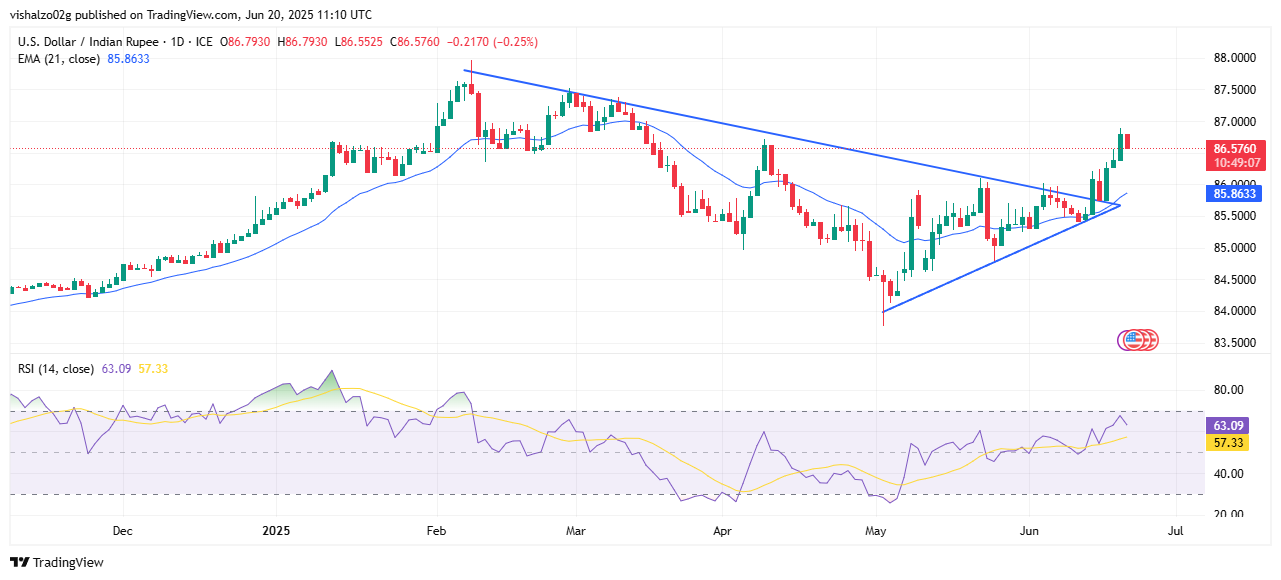- INR recovers slightly on Friday, lifted by gains in domestic Stocks and a softer US Dollar.
- Brent Crude Oil trims recent gains but holds a weekly rise of over 4% so far as Middle East tensions persist.
- Equity benchmarks Sensex and Nifty rally over 1% each, snapping a three-day losing streak.
The Indian Rupee (INR) snaps its three-day losing run against the US Dollar (USD) on Friday, recovering modestly after hitting a three-month low the previous day. A softer Greenback and a pullback in Crude Oil prices lent support to the Rupee, as traders digest US President Donald Trump’s two-week delay to decide if the US will step into the Israel–Iran air conflict.
USD/INR is drifting lower during the American trading hours, last seen trading around 86.60 at the time of writing. The pair has eased from its multi-month high but remains up over 0.50% for the week, underpinned by elevated Crude Oil prices amid the ongoing Iran–Israel conflict.
While Trump’s two-week window to decide about Iran has temporarily calmed fears of an immediate escalation, risk appetite stays fragile as the conflict entered its eighth day on Friday with continued missile strikes and no clear path to de-escalation. Investors remain cautious that any miscalculation could disrupt energy flows and weigh further on emerging market currencies like the Rupee, particularly if Crude Oil prices reverse course and climb higher again.
Market Movers: Oil, Equities, Geopolitics shape Rupee moves
- The Indian Rupee edged higher on Friday, aided by strength in domestic equity markets, which helped lift sentiment. A relatively steady trend in global Crude Oil prices also provided some relief to the energy-import-reliant currency.
- Fresh domestic data is reinforcing India’s growth outlook. A new report from Motilal Oswal Private Wealth (MOPW) on Friday noted that the economy is benefiting from multiple supportive trends: GDP growth accelerated to 7.4% in Q4 FY25 — the strongest in a year — while inflation has stayed below 4% for four straight months, and GST revenues continue to rise steadily. These factors point to robust demand and stable formal-sector activity, helping underpin market sentiment for the Rupee.
- India’s benchmark equity indices bounced back sharply on Friday after three days of losses, boosting overall market sentiment. The 30-share BSE Sensex jumped 1,046.30 points, or 1.29%, to close at 82,408.17, while the NSE Nifty50 rose 319.15 points, or 1.29%, to finish at 25,112.40.
- The Rupee, like most Oil-sensitive Asian currencies, has been under pressure this week as fears of a wider Middle East conflict fuel concerns about higher Oil prices and renewed risk aversion. The Rupee was down about 0.75% through Thursday, on track for its worst weekly performance in one and a half months, according to Reuters.
- Brent Crude has slipped over 2% so far on Friday, easing near $77 per barrel as traders reacted to signs that the US may hold off immediate military action in the Israel–Iran conflict. Despite the dip, prices are still set for a weekly gain near 4%, keeping energy markets sensitive to any fresh escalation that could disrupt supply routes.
- Investor nerves remain heightened as the Iran–Israel war entered its eighth day, officials on all sides continue to trade sharp warnings. US President Trump reiterated on Thursday that he would “make a decision in the next two weeks” but stressed he still believes “there is room for diplomacy” with Tehran. Israel’s Prime Minister Benjamin Netanyahu declared that his country “will act alone if necessary,” signalling readiness to strike Iran’s Fordow nuclear site without US assistance. Meanwhile, a senior Iranian lawmaker warned that closing the Strait of Hormuz is “a real option” if Washington escalates, calling US military involvement a clear “red line” for Tehran.
- Anil Kumar Bhansali, Head of Treasury and Executive Director at Finrex Treasury Advisors LLP, told PTI, “The uncertainty over the Iran–Israel conflict persists, and US President Donald Trump has merely postponed America’s entry into the war by two weeks. The Rupee is expected to trade in the 86.35–86.95 range. Exporters are in a good position to sell dollars now, as the Rupee could appreciate to 85.50–85.75 levels in July if hostilities ease.”
- The US Dollar Index (DXY), which measures the Greenback’s value against a basket of six major currencies, edges lower on Friday, slipping back below the 99.00 mark. The index has eased from its weekly high touched on Thursday, and was last seen trading near 98.75 as traders reassess safe-haven demand.
- The Philadelphia Fed Manufacturing Index held steady at -4.0 in June 2025, unchanged from May and missing market expectations of a milder decline to -1. The reading highlights that manufacturing activity in the region remains sluggish, hindered by softening demand and cooling labor market conditions. Firms surveyed reported weaker new orders and a modest drop in employment, adding to evidence that the sector is losing momentum amid elevated borrowing costs and lingering economic uncertainty. Earlier this week, the central bank kept its benchmark rate unchanged at 4.25%–4.50% during its July meeting, as officials weigh sticky inflation against signs of slowing growth.
Technical Analysis: Bulls pause after multi-month high, key support at 86.00 in focus

USD/INR is showing early signs of a potential pause after a decisive breakout from a multi-month symmetrical triangle. Friday’s price action is forming a bearish daily candle, highlighting that the pair is struggling to hold gains after testing the psychological 87.00 barrier.
The breakout above the triangle resistance and the 21-day Exponential Moving Average (EMA), which now sits around 85.86, confirmed a shift in near-term sentiment from neutral to bullish earlier this week. However, the pair’s failure to close firmly above 87.00 has attracted profit-taking, raising the risk of a short-term pullback.
The Relative Strength Index (RSI) has cooled slightly from near overbought territory but remains comfortably above the neutral 50 level, suggesting that buyers still have control as long as the pair stays above the former triangle resistance, now acting as a support zone around 85.80–86.00.
Indian Rupee FAQs
The Indian Rupee (INR) is one of the most sensitive currencies to external factors. The price of Crude Oil (the country is highly dependent on imported Oil), the value of the US Dollar – most trade is conducted in USD – and the level of foreign investment, are all influential. Direct intervention by the Reserve Bank of India (RBI) in FX markets to keep the exchange rate stable, as well as the level of interest rates set by the RBI, are further major influencing factors on the Rupee.
The Reserve Bank of India (RBI) actively intervenes in forex markets to maintain a stable exchange rate, to help facilitate trade. In addition, the RBI tries to maintain the inflation rate at its 4% target by adjusting interest rates. Higher interest rates usually strengthen the Rupee. This is due to the role of the ‘carry trade’ in which investors borrow in countries with lower interest rates so as to place their money in countries’ offering relatively higher interest rates and profit from the difference.
Macroeconomic factors that influence the value of the Rupee include inflation, interest rates, the economic growth rate (GDP), the balance of trade, and inflows from foreign investment. A higher growth rate can lead to more overseas investment, pushing up demand for the Rupee. A less negative balance of trade will eventually lead to a stronger Rupee. Higher interest rates, especially real rates (interest rates less inflation) are also positive for the Rupee. A risk-on environment can lead to greater inflows of Foreign Direct and Indirect Investment (FDI and FII), which also benefit the Rupee.
Higher inflation, particularly, if it is comparatively higher than India’s peers, is generally negative for the currency as it reflects devaluation through oversupply. Inflation also increases the cost of exports, leading to more Rupees being sold to purchase foreign imports, which is Rupee-negative. At the same time, higher inflation usually leads to the Reserve Bank of India (RBI) raising interest rates and this can be positive for the Rupee, due to increased demand from international investors. The opposite effect is true of lower inflation.

